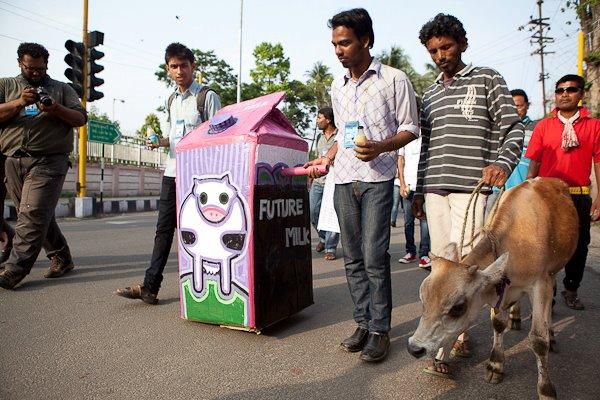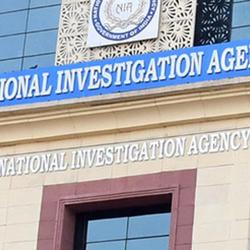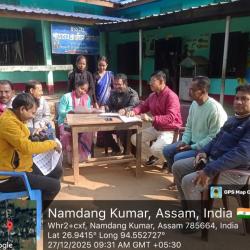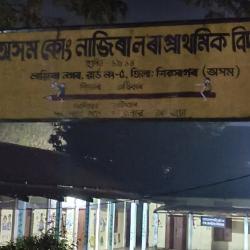On a busy Monday afternoon of 30th April, the people around Latashil field and The High Court were caught by surprise when some young boys and girls approached them with a bottle of “Future Milk”. Priced at Rs. 200 for just 100 ml, this “Future Milk” can do wonders. One sip a day can make you lose weight, have beautiful hair and glowing skin. Topping the list, it also provides all the nutrition required by a human body in a day and even if you skip meals, you will still feel energetic and healthy! Interested? Contact “The Yellow Cab”, a city based group of young people who in their own words “aspire to promote our views using multiple methods like video projection, digital text, news print, performance & visual array to achieve our goal…. Our idea is to project ART & its demand to project social change with a contemporary perspective.” The Yellow Cab in collaboration with Artefacting Guwahati had performed that brilliant piece of what they call “Public Art” depicting increasing corporatization of our basic eating habits. In what would the artists at The Yellow Cab say “ people have forgotten even to make best from either cultivation or livestock farming. In this particular work, the packed milk product personifies such extent of industrialization and the common man’s dependability on such products.”

It was interesting to observe peoples responses to this. Some thought these guys were engaged in some kind of marketing activity. Some even asked if they would seriously “lose weight” after drinking the milk. 40% of the people approached agreed to buy that. Of course the artists then explained the concept and returned the money. Some loved the idea while some laughed at it.
Undaunted, the artists continue with the Art performance till evening. Many like the lawyer outside the Circuit House contributed the amount as a goodwill gesture.
This performance was the start up of the bigger event by Artefacting Guwahati which is scheduled for 19th May.
Their three month project, titled “Global Village 2012” has seen a diverse collaborative of local artists from the northeast, mixing with the Artefacting team members from Europe, USA and India to work together creatively towards common objectives and education. International exhibitions and a feature film will intimately deliver these experiences and Artefacts to viewers across India and abroad through curated exhibits in museums, galleries and theatres. With the assistance of Artefacting leaders and key partners, relationships with communities will spurn effective working environments that can lead to meaningful and profound collaborative work.
The team’s diverse assets, backgrounds, abilities and networks will give a capacity to allow small projects to materialize into events of cultural and community significance; a festival, the creation of land art, a photo shoot, film production or a deep immersion & recording of a cultural tradition.

The main faces at Artefacting Guwahati team are Arne de Knegt who as a photographer and idealist, views Artefacting as a way to re-shape the way we think about our world and the many components it consists of. With him is Parasher Baruah who hails from Dibrugarh, a filmmaker who tries to bring north east into the mainstream through films, photographs and of course Artefacting. Annalisa Iadicicco is a mixed media artist who works in installations and photography. She worked with several years with major movie and television productions she is now focusing on creating art from raw materials and photography. With them there are a host of local collaborators from Assam like Utpal Das, Sanjib Sabhapandit, Tanmoy Thakur, Dilip Tamuly, Aiyushman Dutta and Alak Pathak to name a few. Actively participating and contributing are the enthusiastic students from Guwahati College of Architecture, The Yellow Cab, Anga Studio, NDTV IndiaCan Broadcast Journalism Institute and Gauhati Artists Guild.
In Guwahati, the main event is proposed to be held by the Uzan Bazaar riverside. The viewer will be led to a centre point from where one can explore the various audio-visual experiences. The layout will leave the viewer to decide for themselves between the various installations; resembling the ''cross roads' that the modern generation is facing - in deciding where to go, what to do, who to become - that of a 'culture in transition'.
- Mayuri Rajkonwar
- Add new comment
- 72735 reads










Comments
Pages
Add new comment